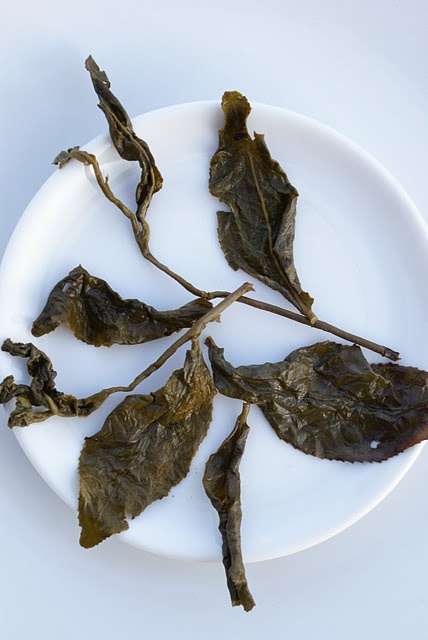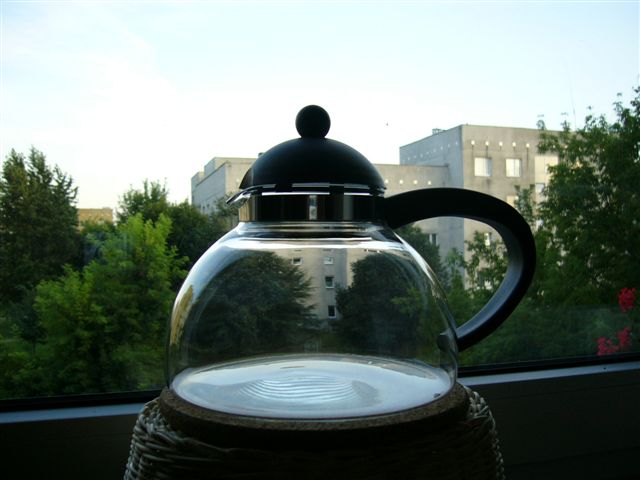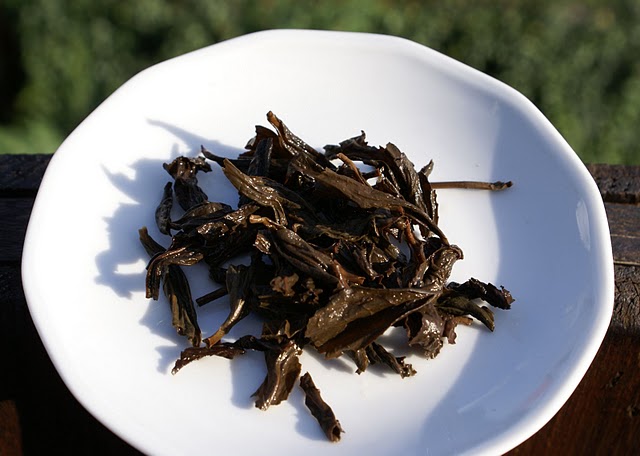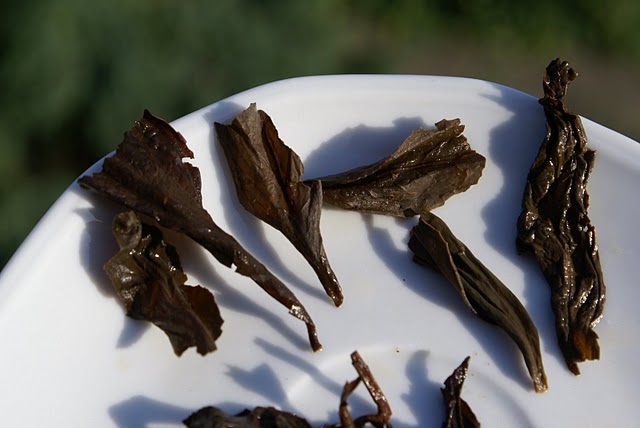An exercise matching tea and chocolate. Can this work at all? Isn’t chocolate too powerful to have with tea? I try some artisanal chocolate pralines with green, oolong, black and puer tea.
How to brew decent tea while travelling? Without access to infinite tea supply from your own tea cabinet and 25 brewing utensils. The answers are: keep it simple; carry your own tea; choose a tea that will perform well in less-than-perfect circumstances.

But there’s another aspect to that. Overdo that Wagner listening, and all his operas will seem like one repetitive ramble. After two weeks of drinking only Japanese shincha three or four times a day, I didn’t feel like having more, and all those notes of green fruit and mild astringency on the palate really didn’t make much difference. So it’s good to switch to something different after a while. Yet the first sips of that ‘different’ tea (wine, food, music) always seem strange. Everything’s out of sync. The mouthfeel is not what it’s supposed to be. Even a tea’s colour can seem anomalous.
 These leaves are very slow to open…
These leaves are very slow to open…But in my case, the tea had to be special. With so many old wine vintages being poured, I wanted a tea with several decades on it. Old puer was best avoided, though, as the taste could be challenging to some diners. So I went for this 1976 Baozhong from Tea Masters (see description here
; the tea is out of stock at the moment, although Stéphane says it might be available again in the autumn).Last week’s anniversary dinner was an eye-opener for this Baozhong, after circumstances forced me to change my brewing style. To accommodate so many people, I had to choose a really large pot. My choice went for this glass pot which contains roughly a liter:
It’s the equivalent of what is called ‘glass brewing’ or ‘bowl brewing’ (see discussions here
 Looking at the wet leaves, it’s no surprise this tea is so good. The roast has been really virtuosic as many leaves are still dark green in colour (have a closer look at the twisted leaf to the far right of the photo below). And for their age, they are really impressively intact. On top of it, it’s a really inexpensive tea for its age (40€ / 100g). Dear Stéphane, I truly hope you can source some more!
Looking at the wet leaves, it’s no surprise this tea is so good. The roast has been really virtuosic as many leaves are still dark green in colour (have a closer look at the twisted leaf to the far right of the photo below). And for their age, they are really impressively intact. On top of it, it’s a really inexpensive tea for its age (40€ / 100g). Dear Stéphane, I truly hope you can source some more!
Jinxuan (a.k.a. as Taiwan No. 12) is one such variety of tea tree, and apart from good productivity it is known for its creamy or milk-like aroma. This is as much a blessing as a curse, as many unscrupulous producers of lower-end oolong simply boost this subtle natural aroma with artificial flavouring. The result, sold as ‘Milk Oolong’, can be so utterly repulsive I have pretty much lost any confidence in jinxuan altogether. I thank Stéphane all the more, therefore, for having sent this very enjoyable sample.
All in all this an enjoyable tea with a very subtle, unobtrusive ‘milky’ aroma. But it also shows why the jinxuan variety doesn’t have the pedigree of qingxin: this tea just lacks the structure, depth and finesse of the latter.
2g of leaf after 5 minutes of infusion.
A springtime delight
High mountain (gaoshan) oolong from Central Taiwan is one of the world’s best teas, and Shan Lin Shi is one of the most famous appellations (origins) here. No wonder, therefore, that leading Taiwan tea internet specialist Tea Masters are offering no less than a dozen varieties from each vintage including six from Shan Lin Shi alone, at the time of writing.
As the spring is here and I am waiting to place an order for 2009 oolongs, I am slowly finishing my sample of the 2008 Shan Lin Shi Spring Luanze. As most of the top gaoshan oolongs, this is made from the qingxin tea cultivar, also known as luanze (and identified as such on the Tea Masters catalogue). There will be experts around to explain it fully but the reason why qingxin is preferred to other tea cultivars (such as jianxuan or the most widespread sijichun) is the inimitable buttery mouthfeel it gives, along with good ageing potential for the more roasted types.
See here for background about this tea, which was picked on 30th April 2008 at 1650 meters of altitude and underwent no roast; the oxidation is also rather low, giving a tea that’s close to a green in aroma and lightness, but showing a bit more substance and sturdiness than most green teas.
Price: 28 € / 100g (and worth every penny)
Brewed in: gaiwan
Dosage: 4 g / 120ml
Leaf: Appearance is the usual tightly rolled green leaf with a bit of stem attached. Dry leaf aroma is clean and very pleasant, reminiscent of the leaves and petals of first spring flowers (tulips perhaps).
Brewing #1 (30 seconds).
Tasting notes:
30s: The aroma is surprising for a gaoshan in being only vaguely floral, and quite vegetal-leafy. Flavour is again less floral than many teas of this style: mild, soft, light, with only a bit of dryness on end. As it cools down there is quite an inviting velvety texture and an understated, clean, satisfying vegetal taste.
30s: Seems denser in texture and flavour, with some grainy, mealy notes adding to the vegetality.
30s: Now a little lighter, no floweriness at all, and some grip on the finish. In fact this is going along the lines of brewing #2 in showing a touch of roast perhaps (?? Tea Masters are indicating there is none): against many featherlight and unsubstantial renditions of Shan Lin Shi, this tea has guts, and has in fact survived the 360 days of ageing more than well. Altogether a highly satisfying version of its appellation. Stay tuned for tasting notes of other SLS types offered by Tea Masters.
Brewed in: zisha teapot
Dosage: 2.5g / 120ml
Dry leaf: rather smallish, straight and twisted. Considerably darker in colour than the AAA Yulan from Jing reviewed yesterday. Lovely aroma of orange spice and roasted almonds.
Infusion #1.
This tea-producing area is also renowned for the large amount of old wild trees still in use (the top teas are allegedly 100% old growth, and some even advertised as ‘single bush’; Dancong originally means just that); as a drawback, prices for the top grades are very high, often pushing $100 / 100g in the West.
Here I look at the 2008 Dancong Yulan AAA purchased from
Jing Tea. At $29 per 100g, it can be said to be reasonably priced for an ambitious Dancong. Yulan means magnolia, so we know what aroma to look for. With Huangzhi (‘Orange Blossom’), this is the most popular variety of Dancong.Brewed in: gaiwan
Dosage: 3.5g / 120ml
Dry leaf: Long and rather straight leaves that are surprisingly green. Usually Dancong is a medium oolong, meaning a moderate (~50%) oxidation. Here, there clearly is less. The aroma is extraordinarily flowery, with a mixture of orange blossom, lilac, and lilies perhaps.Tasting notes:
30s: A clear, saturated yellow colour. Intense aroma is consistent with the dry leaves, narcotically flowery. Palate also has a flower petal bittersweetness, and an almost buttery texture with no aromatic other elements such as fruits or spices. Elegant, smooth, with good presence on palate and a longish finish. Rather elegant for a DC, this reminds me of Baozhong with its extravagant flowery crest over a rather slim body.
1m (overbrewed): Colour deepens into a yellow+. Interestingly this has not become bitter, but there is a flowery dustiness at the back of the throat.
45s: Now lighter in flavour and a little neutral, as if suffering from the previous, excessive infusion.
1m: Back to shape now. As often with Dancong, the initial top floral notes are gone, but what remains is a solid medium-bodied architecture and a streak of solid, invigorating, elegantly bitterish flavour akin to grated orange or grapefruit zest.
Huang Jin Gui
Merchant:
Tasting notes:
20s: This appears a little overbrewed, showing in a concentrated yellow-green colour, and some tannic astringency on the palate. Aroma is Anxi-floral with a bit more grassiness and grapefruit peel pungency than a typical TGY. An assertive tea, fullish on the palate while keeping the green drive of the nose. Good tea here, but I would double the amount of water for this amount of leaf.
20s with 130ml water: Colour more into greenish. Floral but a little subdued (some leaf burn?). Palate less astringent, assertive, full-flavoured. Good quality here.
30s: Strangely weaker and flatter now, without the expressive force of the above brewings. Good vegetal length. Subsequent brewings are gradually losing intensity, but overall pleasurable.
Definitely a re-purchase at this price ($9 / 100g).
Competition Grade Se Zhong–Mao Xie
Merchant: Jing Tea
Brewed in: gaiwan
Dosage: 4g/120ml
Dry leaf: A typical Anxi rolled leaf. Aroma is also typical: grassy, vegetal, but also highly floral and exotic-fruity. Nice.
Tasting notes:
25s: Lid aroma is again very floral (pink and white lilies came to mind). Idem but slightly less precise in cup. An elegant, fruity-floral tea, this seems less structured than the typical TGY.
30s: Lid aroma now more vegetal, less floral. Despite being less structured than many Anxi oolongs this is an assertive tea with very good ‘palate presence’.
40s: Much as brewing #2, good length, good personality, this has all to please. The open leaves seem thinner and less serrated than a TGY, and are almond-shaped; clearly this is another varietal:
60s: Similar to above, floral and fresh but palate a little fading now. Overall expression is still quite good.
60s: A delightful brewing, mild but flavourful.
3m: Still a vestige of the high-pitched flowery aroma and enough flavour on palate to be interesting. Which is not bad patience for a rolled oolong IME.
Overall this is firmly Anxi in style but a little less structured and sweeter than a TGY. Excellent tea. And at $12 per 100g, it is also brilliant value.